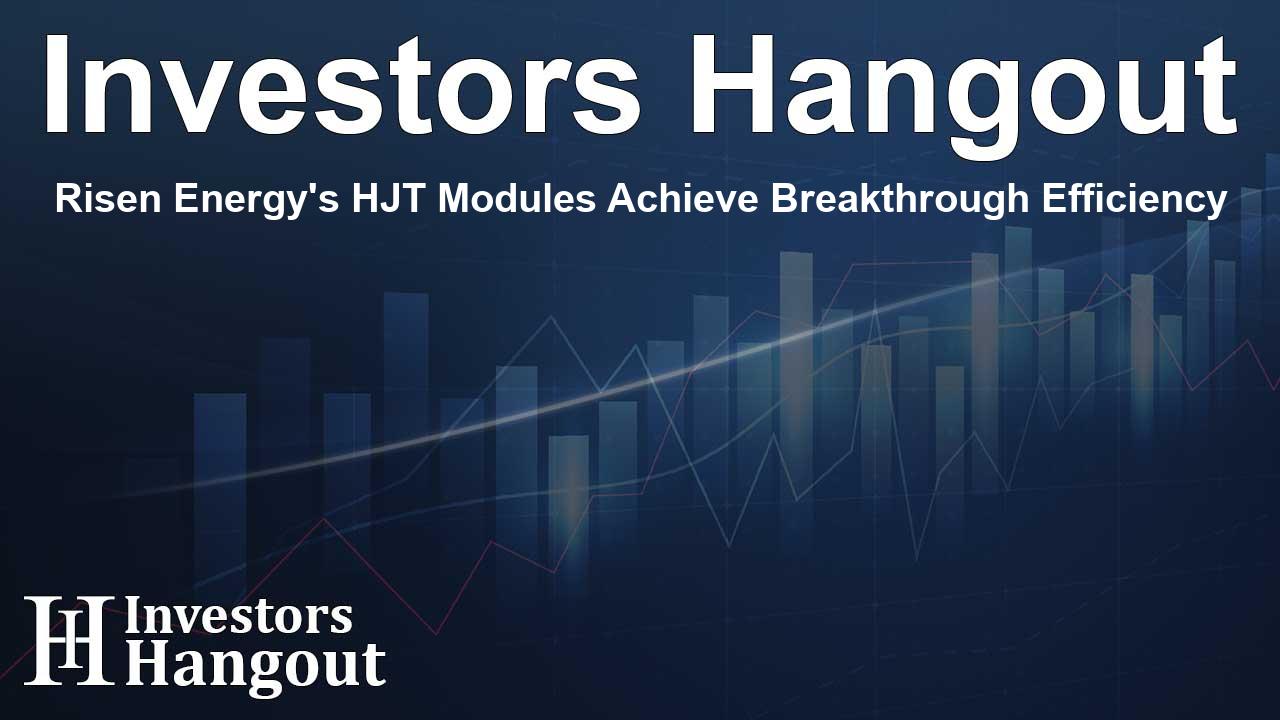Risen Energy's HJT Modules Achieve Breakthrough Efficiency

Revolutionary Achievements in Solar Technology
Risen Energy Co., Ltd., a pioneer in photovoltaic technology, is making headlines with the launch of its groundbreaking Hyper-ion HJT modules. These modules have reached an impressive average power output of 740Wp during mass production, establishing a new industry standard. The innovative technology behind these modules showcases a remarkable cell conversion efficiency of 26.61%, signifying a major step in the integration of research and development into practical applications. This achievement solidifies Risen Energy's frontrunner status in high-efficiency communication technology.
Core Innovations and Technological Advances
The advancements achieved in the Hyper-ion technology stem from a focus on patent-protected innovations and strategic development initiatives. Risen Energy has leveraged significant research programs to enhance structural designs while simultaneously reducing costs:
Innovative Metallization Techniques
One of the standout features of the Hyper-ion modules is the substantial upgrade in metallization. By cutting silver consumption to just 5mg/W—representing a 37.5% reduction compared to traditional TOPCon methods—Risen Energy has managed to lower non-silicon costs efficiently using stencil printing techniques.
Enhanced Module Performance
Another vital improvement is found in the low Cell-To-Module (CTM) loss during production. Risen's improved encapsulation processes have minimized CTM losses to a mere 1.8%, while keeping cell breakage rates significantly below 0.03%. This enhancement guarantees high-yield manufacturing, ensuring that more modules reach the market without compromising quality.
Environmental Benefits and Performance Metrics
The Hyper-ion modules not only focus on efficiency and cost but also prioritize eco-friendliness. Notably, the modules provide a temperature coefficient of -0.24%/°C and excellent bifaciality, achieving a 4.09% greater power output compared to their counterparts in tests conducted at SGS sites. Peak monthly energy production gains have shown to be remarkable, with maximum outputs reaching 6.04%. When evaluated for larger projects, the impact becomes substantial:
Impressive Energy Generation and CO? Reduction
- Each 100MW installation can generate over 3 million kWh annually.
- This leads to a reduction of approximately 2,880 tons of CO? emissions.
- The carbon footprint can reach as low as 376.5 kg equivalent CO? per kWc.
Expanding Global Market Potential
The Risen Hyper-ion Pro series is positioned as a prime choice for a variety of applications, including utility-scale, commercial, and high-temperature projects. The market interest is reflected in:
- Over 9GW of specific tenders anticipated for HJT technology in the coming year within various regions.
- Plans to broaden the reach of the technology into more than 50 countries, including markets in the Middle East and Southeast Asia.
- A verified energy gain of over 6% in high irradiation areas of Saudi Arabia and the UAE, crucially reducing Levelized Cost of Energy (LCOE).
Leadership's Vision for the Future
According to Dr. Yang Pochuan, head of the Risen Global PV Research Institute, the company is setting ambitious goals, targeting efficiencies exceeding 27% for cell production and exceeding 790W for monocrystalline modules within the next three years. Furthermore, the development of perovskite tandem technology aims for mass production of modules exceeding 850Wp by 2028, contributing to global sustainability efforts and the transition towards net-zero energy solutions.
Frequently Asked Questions
What are HJT modules?
HJT modules refer to heterojunction technology modules that combine both crystalline and amorphous silicon layers to improve efficiency and performance.
What is the significance of 740Wp power output?
A power output of 740Wp signals a new benchmark in solar efficiency, providing more energy generation capabilities per unit area.
How does Risen Energy's technology reduce CO? emissions?
The technology focuses on high efficiency and reduced energy production costs, leading to lower greenhouse gas emissions across the manufacturing and performance lifecycle.
What future goals does Risen Energy aim to achieve?
Risen Energy aims to reach cell efficiencies greater than 27% and produce modules exceeding 850Wp by 2028, contributing to global clean energy efforts.
Where are Risen Energy's products being deployed?
The products are targeting utility-scale and commercial applications and are expected to be deployed in over 50 countries worldwide.
About The Author
Contact Kelly Martin privately here. Or send an email with ATTN: Kelly Martin as the subject to contact@investorshangout.com.
About Investors Hangout
Investors Hangout is a leading online stock forum for financial discussion and learning, offering a wide range of free tools and resources. It draws in traders of all levels, who exchange market knowledge, investigate trading tactics, and keep an eye on industry developments in real time. Featuring financial articles, stock message boards, quotes, charts, company profiles, and live news updates. Through cooperative learning and a wealth of informational resources, it helps users from novices creating their first portfolios to experts honing their techniques. Join Investors Hangout today: https://investorshangout.com/
The content of this article is based on factual, publicly available information and does not represent legal, financial, or investment advice. Investors Hangout does not offer financial advice, and the author is not a licensed financial advisor. Consult a qualified advisor before making any financial or investment decisions based on this article. This article should not be considered advice to purchase, sell, or hold any securities or other investments. If any of the material provided here is inaccurate, please contact us for corrections.
